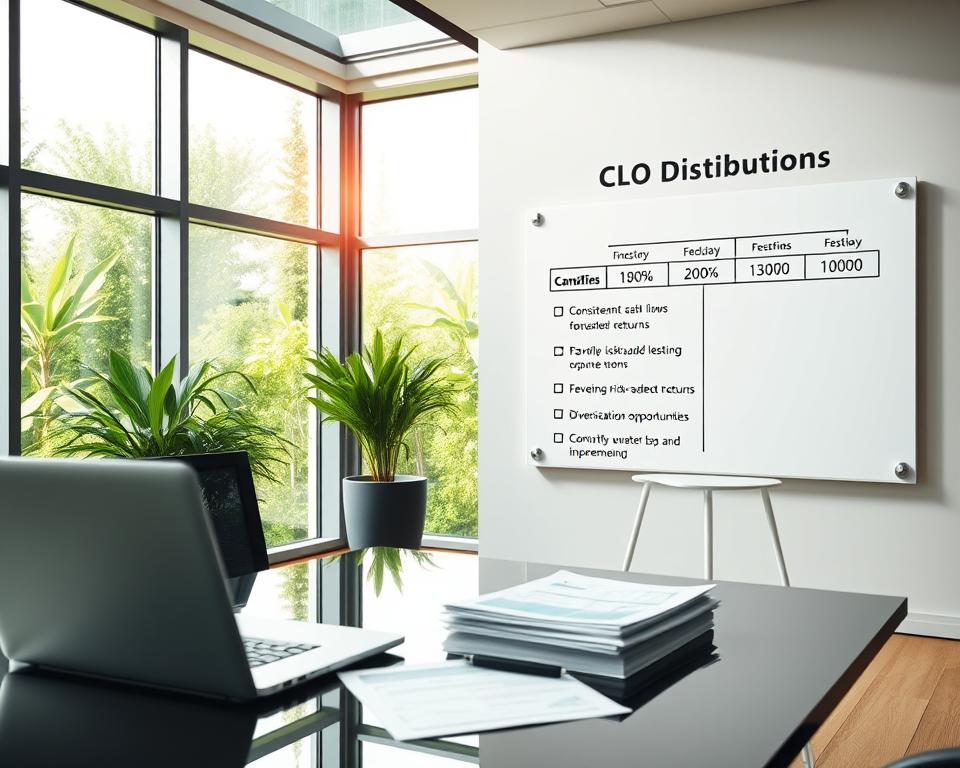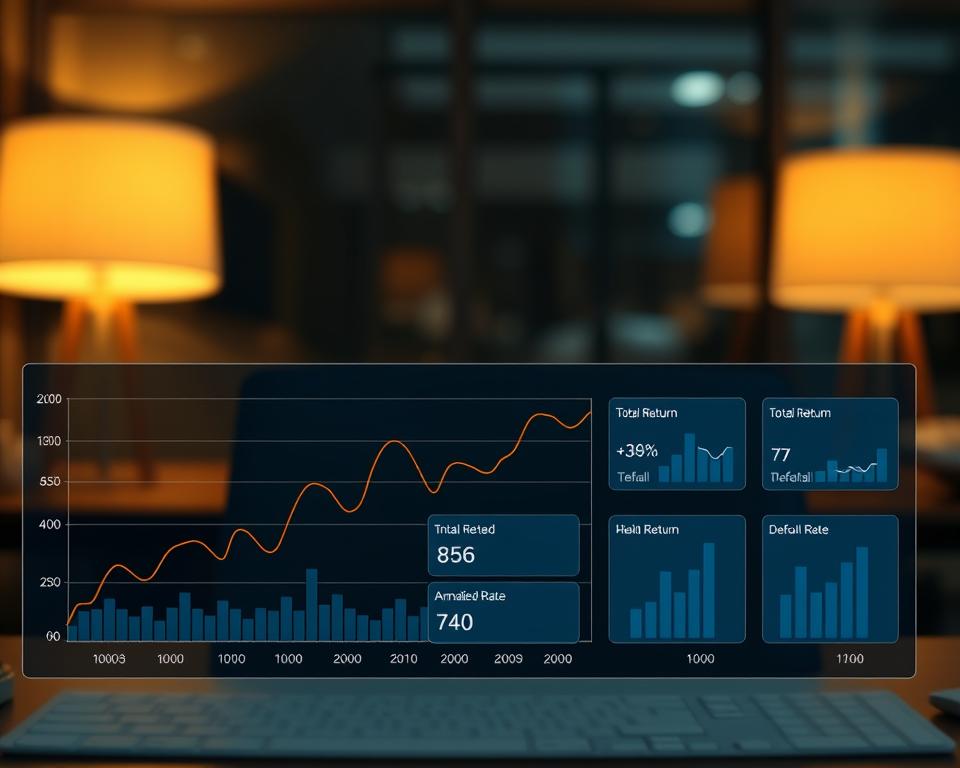CLO Equity Investing Insights – An Overview
Over 60% of institutions recognize CLOs as essential to their investment mix—did you know that? A look into CLO equity firms uncovers the reasons behind its growing allure. Investors enjoy the prospect of compelling yields, steady cash flows, and risk spreading. They provide a safeguard against market volatility.
Here, we unpack the essentials of CLO equity. We’ll discuss the importance of seasoned CLO managers, the unique aspects of CLO equity funds, and the role of structured finance investors. By the end, you’ll understand why CLO equity is a compelling choice for investors aiming to boost their portfolios.
- CLOs provide robust portfolio diversification to large investors.
- The cash flow dynamics of CLO equity can provide attractive returns.
- The track record of seasoned managers greatly influences results.
- These investments often act as a cushion during market slumps.
- Alternative investors are turning more to CLO equity funds.
CLOs & Equity Tranches Explained
Understanding CLOs highlights their importance in the financial landscape. These structured products are built from non-investment grade, senior-secured loans. They make up a significant part of the $1.4 trillion structured credit market. Investors are keen to grasp the essence of these instruments, focusing on what CLO equity represents.
Equity holders participate in cash flows once senior obligations are met. In a low-rate environment, this feature delivers attractive income potential. The floating-rate nature of CLOs also serves as a shield against rate volatility. This makes CLOs an attractive investment option.
Knowing the anatomy of CLOs and their equity slice is critical for sizing up risk and reward. My goal is to clarify these concepts. I aim to show their importance in guiding investment choices.

The Case for CLO Equity
These funds provide a novel diversification opportunity. Investors are drawn by proven performance and yields. In volatile markets, its stability is a key draw, positioning CLO equity as a top pick.
The Attractive Return of CLO Equity
Double-digit annualized cash-on-cash gains are typical in CLO equity. In the reinvestment window, returns frequently reach high-teen territory. Hence, it ranks high among high-yield options that maintain credit standards.
CLO Equity’s Track Record
Built-in resilience shines through CLO equity’s past results. Unlike private equity, which may have a J-curve effect, CLO equity offers consistent quarterly distributions. Consequently, it’s a dependable means to manage risk while hunting yield, cementing its market standing.
How CLOs Are Built
Their complexity belies the attractive opportunity they offer. At their core is the cash flow waterfall, a system that outlines how payments are allocated among different tranches. Each tranche has its own risk and return profile. The safest, highest-rated tranches get paid before all others. In contrast, subordinated tranches carry more risk for the chance of higher returns.
CLO collateral consists mainly of senior-secured debt. They hold a first-lien position, ensuring they are prioritized in payment distributions during bankruptcy. Hence, CLOs often carry lower risk than plain corporate bonds, suiting risk-aware investors.
Defining Features of CLO Equity
Exploring CLO equity investments reveals a standout feature: their cash flow dynamics. Early, sizable cash payouts accelerate return of capital. This is in contrast to other high-return options, like private equity. Such dynamics cement CLO equity’s niche in credit markets.
How CLO Equity Pays Out
The cash flow dynamics of CLO equity investments are key to their appeal. Early large cash distributions deliver faster return on investment. By the time the equity tranche is considered, cash distributions have already surpassed many traditional investments. This is highly beneficial for institutional investors seeking liquidity without sacrificing upside.
Adapting to Market Shifts
Managers adjust portfolios dynamically through economic cycles. Managers actively adjust portfolios in response to economic changes. Proactive management supports performance in all environments. This flexibility highlights the robustness of equity tranches.
CLOs for Risk Spreading
CLOs introduce new dimensions of risk spreading. They pool varied loans to dilute individual default risks. Their returns often move independently of equities and bonds.
CLO equity firms stand out due to their active management. They monitor and adjust investments to achieve superior performance, adapting to market changes. It’s critical for risk control and portfolio durability.
The loan mix both mitigates risk and levels out distributions. Ideal for anyone needing reliable cash in choppy markets. Investing here helps me implement a more balanced portfolio.
Understanding Potential Downsides
You must recognize the hazards tied to CLO equity. Since markets change rapidly, investors need to monitor credit risks closely. They need to understand where the danger points lie.
Credit Risks in CLO Equity
Loan performance and collateral strength define core risks. Recessions often spike credit losses. If the economy slows, leveraged loans may struggle. Consequently, equity payouts may shrink as collateral quality dips.
Equity investors stand to lose in such stress scenarios. I scrutinize tranche credit metrics and collateral support levels rigorously. It keeps me informed about potential pitfalls.
Trading and Liquidity Concerns
Liquidity shortages pose real threats to equity holders. In times of financial stress, the market for CLO equity can become tight. This restricts the ability to sell or trade these investments without significant losses. Valuation swings often widen in bad markets.
Watching liquidity indicators is vital for risk management. Partnering with teams known for rigorous credit oversight can lessen risk.
Tailoring approaches helps meet return targets within risk limits. There are multiple paths to enter the CLO equity space. Here are some notable strategies:
- Dedicated CLO Funds: They pool equity stakes across targeted deals. They provide a balanced equity basket overseen by pros.
- Direct Deal-by-Deal Investments: It offers bespoke equity positions per deal. It offers more control over my choices but requires deep market knowledge.
- Diversified Credit Vehicles: They blend equity tranches with other debt products. This hybrid approach can lower overall portfolio volatility.
Every option carries its pros and cons. In-house funds aid first-time CLO equity investors. They offer professional management and diversification. Single-deal picks can pay off but demand market savvy. Hybrid credit funds bring together multiple asset types for stability.
Evaluating these options allows me to optimize my mix. It fits my goals, capital base, and risk appetite.
The Role of CLO Managers in Performance
CLO equity managers are essential for the success of collateralized loan obligations. Their decisions in reinvestment windows often lift yields. Active involvement helps firms steer through volatility. It sets them up to maximize gains.
Opting for a proven team matters most. It’s important to select individuals or teams with a proven track record in risk mitigation and refinancing. Veteran teams adjust portfolios on the fly to protect returns. Their judgment and credit selection skills uphold performance amid cycles.
Manager choice often dictates equity outcomes. Appreciating manager impact guides better investment decisions.
Comparative Analysis: CLO Equity vs. Other Investments
Next, we pit CLO equity against private equity and high-yield debt. Our goal is to show how it complements or competes with other options. Understanding these nuances guides optimal strategy.
CLO Equity vs. Private Equity
Several contrasts emerge when lining up CLO equity against private equity. With CLO equity, you get secondary market liquidity and quarterly distributions, while private equity often requires multi-year commitments.
- Risk Profiles: Private equity investments often involve higher risks due to the focus on operational improvements. Pooling many credits tempers single-issuer exposure.
- Performance Patterns: PE can beat CLO yields over time, but CLO equity delivers steadier, high single-digit to low double-digit income.
- Investment horizon: PE holds can last a decade, while CLO equity stakes trade quarterly.
CLO Equity or Junk Bonds?
Now, let’s look at the comparison between CLO equity and high yield bonds. Both are income-generating investments but differ in structure and risk. Junk bonds pay set coupons but swing when rates shift.
- Distribution Benefit: Diversified loan sources spread payment risk.
- Credit risk: HY credit rests on one company, while CLOs dilute single-issuer risk.
- Investment returns: In strong markets, CLO equity yields often exceed junk bonds and hold up better to rate shifts.
Future shifts promise to reshape the CLO arena. CLO ETFs could democratize access and boost liquidity. This development could bring about increased liquidity and transparency, fundamentally altering how we view CLO equity investments.
Regulatory changes are also on the horizon, poised to significantly impact the CLO market. These updates might address concerns over risk management and valuation, leading to more uniform practices. Staying informed on rulemaking helps me adjust my strategy.
Technological advancements in data analytics and risk assessment tools are poised to transform my evaluation of CLO opportunities. By leveraging these technologies, I can gain a more profound understanding of credit quality and market trends. This will enable me to seize emerging opportunities in this ever-evolving investment environment.


